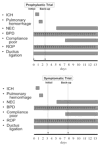Patent ductus arteriosus: evidence for and against treatment
- PMID: 17307530
- PMCID: PMC2723062
- DOI: 10.1016/j.jpeds.2006.12.048
Patent ductus arteriosus: evidence for and against treatment
Figures

Comment in
-
Evidence for active closure of patent ductus arteriosus in very preterm infants.J Pediatr. 2008 Mar;152(3):446-7; author reply 447-8. doi: 10.1016/j.jpeds.2007.10.016. J Pediatr. 2008. PMID: 18280864 No abstract available.
Comment on
-
Neurosensory impairment after surgical closure of patent ductus arteriosus in extremely low birth weight infants: results from the Trial of Indomethacin Prophylaxis in Preterms.J Pediatr. 2007 Mar;150(3):229-34, 234.e1. doi: 10.1016/j.jpeds.2006.11.039. J Pediatr. 2007. PMID: 17307535 Clinical Trial.
References
-
- Van Israel N, Dukes-McEwan J, French AT. Long-term follow-up of dogs with patent ductus arteriosus. J Small Anim Pract. 2003;44(11):480–90. - PubMed
-
- Heymann MA, Rudolph AM, Silverman NH. Closure of the ductus arteriosus in premature infants by inhibition of prostaglandin synthesis. N Engl J Med. 1976;295(10):530–3. - PubMed
Publication types
MeSH terms
Substances
Grants and funding
LinkOut - more resources
Full Text Sources
Medical

